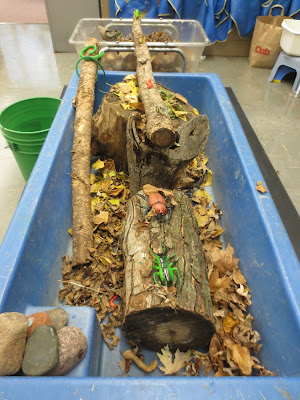If you want to know why this was last's years photo of the year, you can read about it here
Two years ago, this was the photo of the year. This snapshot revealed the traces of children's building in the widow with window blocks. You can read about it here.
This year's photo of the year was taken in yet another area of the classroom, the large motor area. The particular day the picture was taken, the rocking boat was set out on the mat that defines the large muscle area. The children asked to turn over the boat so they could use it as steps. The children used it in many different ways. One of the ways was to lunch themselves off the top step to see how high and far they could jump.
Little did I know that it could be used for something other than large motor play. However, sometime during the middle of class, a child asked me to come over to the steps to see what he had done. This is what he wanted to show me. And this is my Photo of the Year.
I was immediately struck by the symmetry of what he did. I asked him: "What did you make?" He told me: "Pizzas!" Now I was really impressed. He had used triangle Magna-Tiles to make pizzas. As he made each pizza, he would put it on a shelf to cool. He put three pizzas on each shelf for a total of 15 pizzas.
I asked him how he cooked the pizzas? Before I can show you how he cooked the pizza, I have to explain an apparatus that was next to the large muscle area that I had set up earlier in the year.


I installed a horizontal periscope on top of the block shelf. On the left, the the child is putting blocks in one end of the periscope. On the right, he is watching one of the blocks come out the other end of the periscope.
How did he bake the pizzas? He appropriated the horizontal periscope to be his oven.
He would put the pizza in one end of the oven to bake and then take the finished pizza out the other end.
Baking pizza from Thomas Bedard on Vimeo.
When I saw what this child had done, I thought about how we as teachers so often set up and script role play for the children be it a restaurant, a pet store, etc. This child created his own pizza parlor by combining the Magna-Tiles (the pizzas), the horizontal periscope (the oven) and a place to cool and display the pizzas (the upside down rocking boat). In other words, the picture perfectly illustrates a child's meaning making purely through using his imagination to combine totally unrelated elements to create a coherent narrative.
Pizza anyone to go with a Happy New Year?

















































